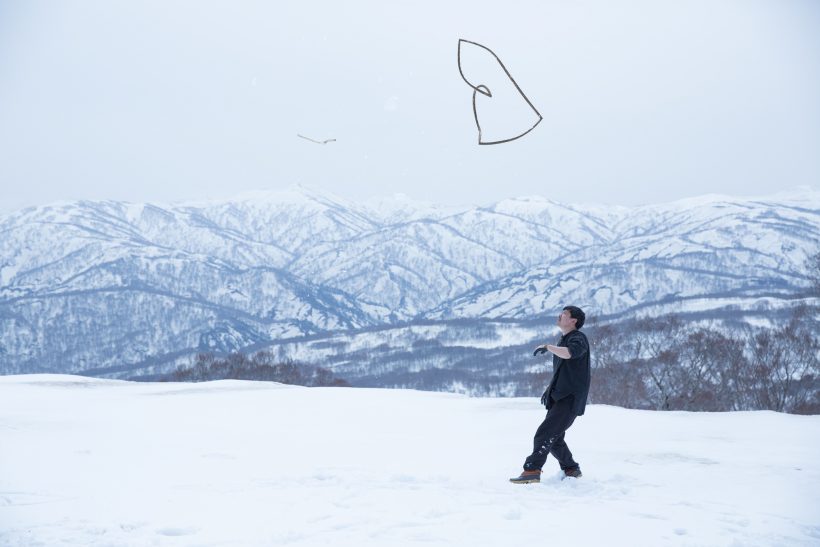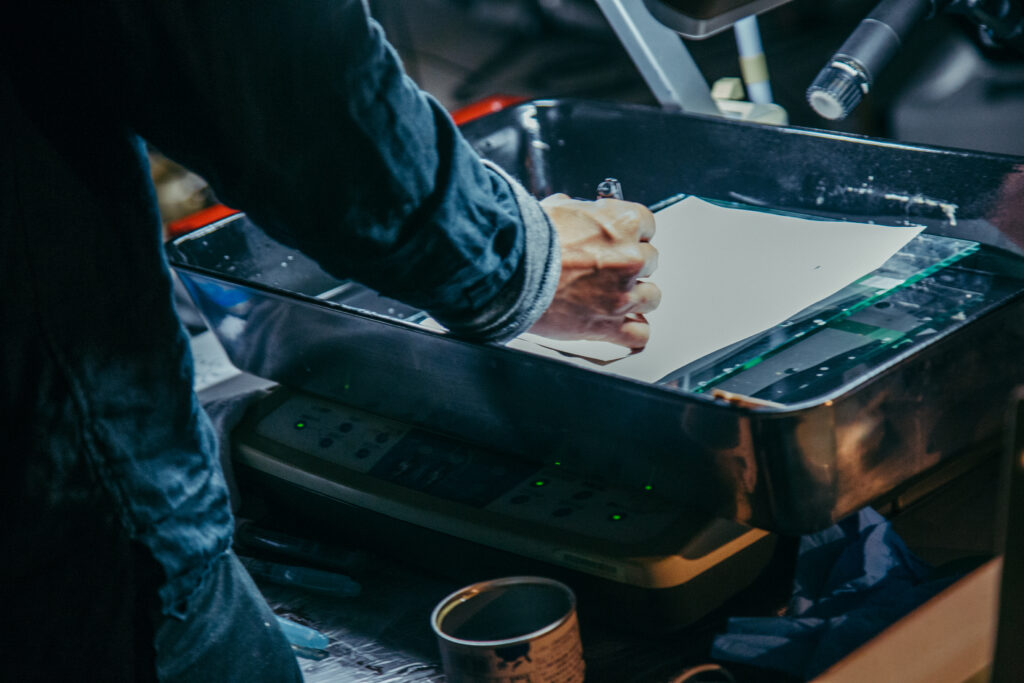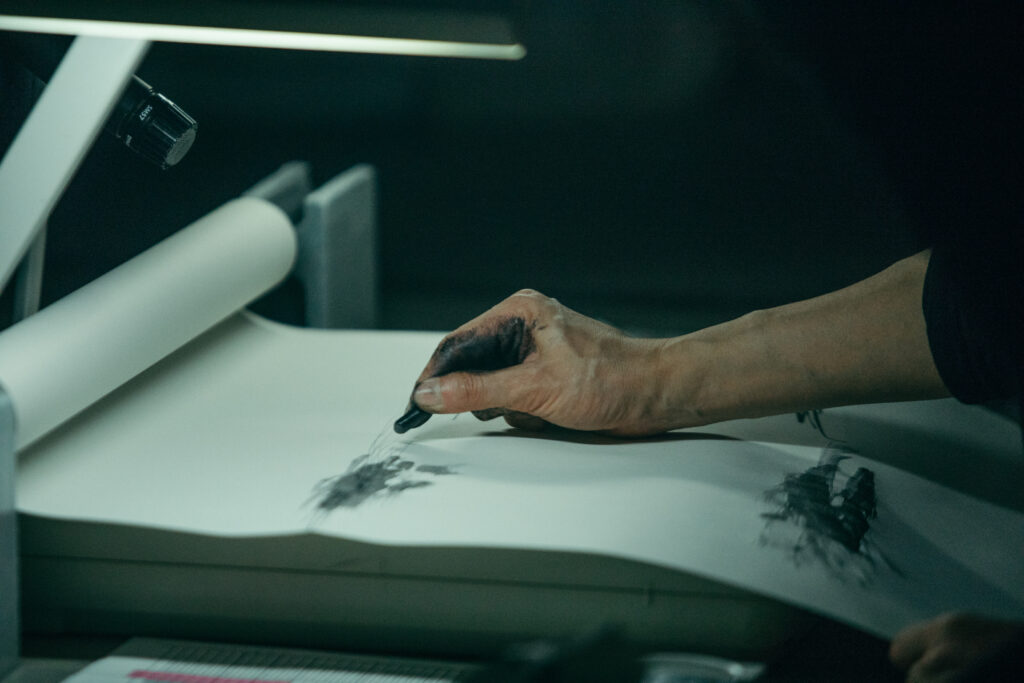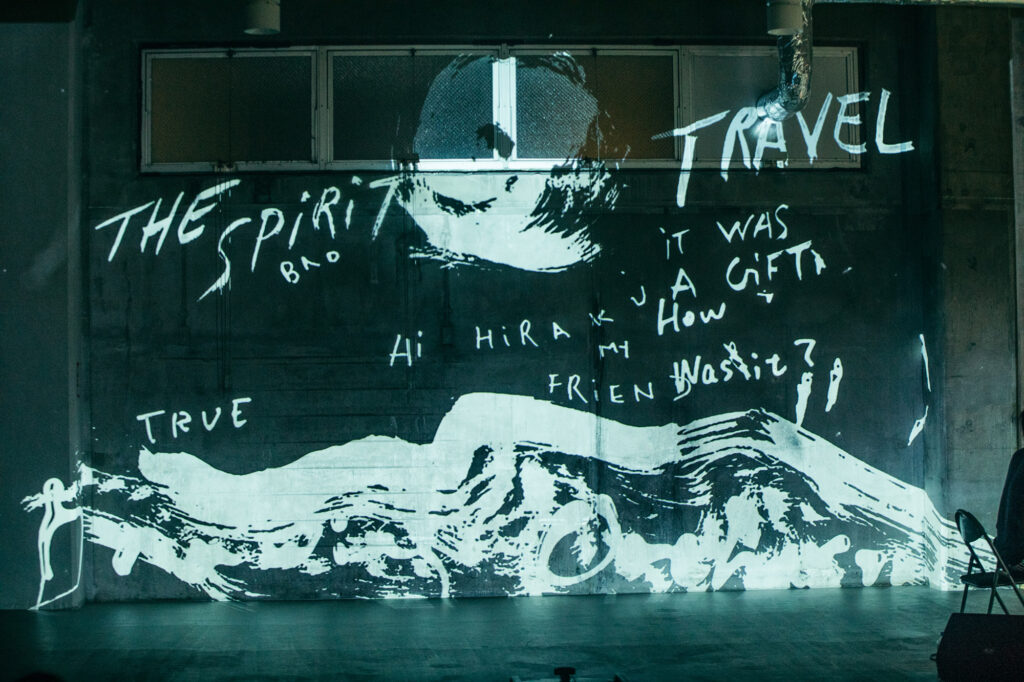Drawing Orchestra is an art project founded by the artists Hiraku Suzuki and designer Daijiro Ohara which invites artists from various practices to perform in a drawing session.They held their second session on March 12th with nine participating artists. In addition to the two founders, Abdelkader Benchamma, the French artist internationally recognized in the contemporary drawing scene, joined the event in real-time. Other artists included painter Akiko Nakayama, whose unique vision uses various liquid and solid materials, Kasetsu, a calligrapher venturing into new calligraphic territory, Mineki Murata, a performance artist questioning the roots of drawing, artist Sohei Nishino, who examines the relationship between photography and drawing, yang02, who explores themes of physicality and individuality through digital media, and NAZE, whose multidisciplinary practice is based on graffiti. Each artist took turns to kaku (draw/write/etch/break/paint) using different techniques and produced substantial images and memories beyond individual creativity, free from the limits of one cohesive artwork. We talked to the founders and participants to examined the project’s content and potential.
Expanding kaku and opening unprecedented possibilities of creativity
—Could you first talk about the concept behind Drawing Orchestra and how you started the project?
Hiraku Suzuki (Suzuki): I’m originally an artist, and I create works based on drawing in a broad sense. I also work in collaboration with other artists or musicians through live drawing instead of solely producing my own pieces in the studio. From around 2005, I started to incorporate document cameras to shoot my hands from above and project the images onto a different screen to expand the possibilities of what I can do in a live setting. This allows me to share my drawings with many people in real-time on a projection screen with a document camera. And I can also overlay other people’s drawings onto mine. In 2016, I used this device to host an event where two artists conversed through drawing, and I established Drawing Tube, a platform that researches and archives contemporary drawing practices in the world. With this event, I focused on expanding the sphere of drawing by having drawing/writing dialogues with artists whose main medium isn’t drawing, such as poets, novelists, and anthropologists. I spoke about this to Daijiro (Ohara) one day. He made an offer: “Why don’t we try doing that with many artists simultaneously?” Both of us saw eye to eye on this idea. This DJ group called the Invisibl Skratch Piklz started a big movement in West Coast hip-hop in the 90s, and we were both inspired by how they scratched on their turntables at the same time to create some kind of echoes.
Daijiro Ohara (Ohara): They didn’t limit their performances to sounds, as they had impactful visuals, too. I felt a link between DJs simultaneously scratching records on their turntables and Hiraku’s (Suzuki) endeavor of hosting a line-drawing session/dialogue. The second he spoke to me about this, I felt like we could start an exciting project if we got a crowd of people to draw. Another thing is the document camera played a significant role. Smartphones are multifunctional—you can do so many things with them—but a document camera is an inept tool, limited to only shooting one’s hands and projecting that. Initially, the only function of turntables was playing records. However, because of scratching, a new [method of] expression became possible. I sensed that document cameras had a similar potential for new means of creating.

Daijiro Ohara 
Hiraku Suzuki
Suzuki: Moreover, the calligrapher Kyuyo Ishikawa had a crucial influence on us. In many of his books, he talks about how the pronunciation of kaku [Japanese: draw/write] is the same for writing words and drawing pictures. If you look at the origin of the word, he says it goes back to: “An act in which one leaves a trace on a surface by engraving it with something sharp.” From there, the meaning of kaku spread out to verbs like scratching/etching (hikkaku), nouns like a plate chipping (kaku), a section (kukaku), and so on. My practice is about exploring the potential of kaku in contemporary art, and Daijiro practices kaku using the methodology of typography. We’re expanding the act of kaku while being active in different fields. Thinking about this made me want to garner more people from different disciplines and explore the undiscovered possibilities of kaku.
—To carry the project out, you held the first event of Drawing Orchestra at the Museum of Contemporary Art Tokyo on February 2nd, 2020, for which artists who kaku in differing ways got together. Were there any difficulties in achieving this event? What did you gain from it?
Suzuki: Because it was an unprecedented project, the anxiety of heading to an unknown destination constantly haunted me. We were confident about the concept and artists selection, but we still had to resolve some technical issues. If you just overlay the drawings on top of one another using the same screen, they’ll just turn into a chaos. Without Tomoya Kishimoto, who oversaw the technical aspects of the visuals, we couldn’t have a clear mix of different lines. First, we inverted the black lines on a white surface and made them look like light against a dark backdrop. Then, we manually connected the multiple lines of light, like weaving a textile. As a result, something new and explosive was created in the time and space of the event, including the vibe of the fully packed venue. I mixed [the drawings] for the first event but I asked Tomoya to do it for the second event, and I took part as an artist.
Ohara: The artists create a conversation on the screen. Each artist keeps a close eye on other artists, inspires each other, and responds to lines with more lines. For the first event, Hiraku (who’s usually the artist) mixed the drawings to compose the artists’ visual conversation on the screen. Rather than just mixing pictures, it seemed like he was drawing the time. It is a little different from a so-called conductor, but his role was quite important to make this project orchestral. In that space, so many wordless dialogues have been exchanged through the screen. This drawing session was realized because each artist had a distinct approach and the generosity of bringing out [the best] in one another. I was excitedly taking it all in, as I’d never seen artists drawing simultaneously alongside a row of document cameras. I felt confident about it.
A drawing session begotten from being considerate of others
—How many meetings and preparations do you have in advance for Drawing Orchestra?
Suzuki: I write the “score” for the order of events, like who starts, when someone comes out as a solo act, when the duo, trio, and quartet have their session, and when and how it ends. I share that with everyone and have meetings with each artist. However, the score is nothing more than a guideline, so it’s not like things have to go according to plan. What’s important is that it’s an improvised, organic conversation. Meaning, the lines or sounds the other person makes could inspire you to come up with lines or sounds you’d never made before. That generates a kind of new language. It’s not a battle of skills, as I understand it as one experimental way to converse with a new language.
—It’s like organically changing the questions according to the answer in a face-to-face conversation, not like answering questions sent by email. For the second session, you had nine participants in all: Abdelkader Benchamma as a guest, you two, Kasetsu, Akiko Nakayama, Sohei Nishino, Mineki Murata, yang02, and NAZE. How did you come up with this lineup?
Suzuki: There are so many skilled artists so I seriously thought about who I invite to the session. Basically you can imagine countless combinations, but you likely encounter the unexpected things when artists from different backgrounds and practices come together instead of two similar artists. Also, I preferred artists who hold an empty space in their mind which could create a chemical reaction by accepting other means of expression, not someone who could only channel their own art. I considered what pair I wanted to see in a session, and the overall balance when everyone “harmonized” first. Then I asked the artists to join.
Ohara: Hiraku included keywords like “ripples” and “big waves” in his score. Thanks to that, the selection of highlighted artists [during a specified segment] became clear. Like, “This timeframe dedicated to liquid imagery is when Akiko Nakayama, who uses liquids in her art, and Sohei Nishino, who uses photo developing technique, come out.”
—In Japanese, kaku has numerous meanings, but drawing and painting are different things in English. Basically draw is about lines, and paint is about pictures. I feel like the word draw has a strong connotation of “to draw out.” For example: draw the line, a draw (tie) in a game, and a drawer. What do you think about kaku as well as “to draw out”?
Suzuki: If painting is an accumulative act of painting layers, then drawing is a subtractive act, as can be seen in its etymology—to carve out trails. Another definition is to pull a thread or draw something out. You can say that drawing something out is the core of what we do at Drawing Orchestra. I anticipate the artists to draw out the art from each other and for them to intersect. There’s significance in each artist’s paths intersecting because they have their unique universe and are embarking on their own path. Also, their trajectory might change after the Drawing Orchestra experience. There are no mistakes in our events. I tell the artists it’s an opportunity to internalize rather than externalize.
—You had the second session on March 12th, the following day of the day that marked a decade since the 2011 Tohoku earthquake and tsunami. Did you have any intentions of relating this event with such social situations?
Suzuki: On the day before the Orchestra, 3/11, we reflected on the ten years that had passed since the 2011 Tohoku earthquake and tsunami as we prepared for the next day. To go back to the beginning of this project, Abdelkader (Benchamma), a friend I’ve always respected, and I were going to have an exhibition together in Tokyo. But because of the pandemic of Covid-19, Abdelkader couldn’t come, then I thought “Why don’t we virtually connect with him in Montpellier, France, and host a Drawing Orchestra session?” And then it happened. Art, social situations, and the environment of the entire earth are always correlated. I always imagine a tube with both ends open rather than a borderline in the closed space. It’s something that connects one faraway thing to another and generate the traffic between them. By drawing, you can not only create lines that divide things but also lines that connect things.
Ohara: Sometimes, situations out of your control form into being on their own, instead of your own will. Drawing Orchestra formed into being along with the artists’ many actions. Being a part of something like this under circumstances one can’t mold is extremely rare.
—Looking back at the second session, could you talk about your impressions? Also, what are your hopes for the future?
Ohara: Because I was the participant for the first one, I went into the second one challenging myself, partially because of Hiraku’s wishes too: “I’m going to do something different from before.” Previously, my primary tool was hand drawing, but this time, I used this software called Illustrator to depict a Bézier curve. During the latter half, I hit my pen against this box and made loud noises. I call this “pen drumming,” and I tried my hand at creating sounds. Sounds are also imperative in Drawing Orchestra, and we asked Toshihiko Kasai to be the sound engineer for the second event. Thanks to Tomoya’s visual mixing and Toshihiko’s unique miking and PA, a space and time outside the screen came into existence. I understood even more deeply that technical engineers are artists too.
Suzuki: There’s no goal with Drawing Orchestra. What’s essential is the process, not arriving at a “correct” answer. It’s exciting to create and share with everyone else that miraculous moment that goes beyond your expectations. In the end, Abdelkader wrote the word “spirit”, and it felt like his spirit flew from France to the venue. Through Drawing Orchestra, I believe we made it possible to communicate on a deep level, including the parts existing words can’t articulate. I can’t verbalize it all because there are so many details, but I hope to reflect on the possibilities we opened with our second experiment and head towards the next session.
Statements from the artists of the second Drawing Orchestra
What kind of event was Drawing Orchestra? What was born there, and what feedback do the artists have? We asked seven artists to give us a comment.
Abdelkader Benchamma (artist)
Thank you very much for this beautiful invitation.
It was so great meeting you by the drawing, beyond the sea and the distance..
I really enjoy it. It gave me a lot of pleasure and feelings, to share this special time of freedom and creativity. Especially today in this very strange time..
It was almost too short!!! I was like, “Oh I want to draw a little more…!!!”
Thanks again for this amazing experience.
Kasetsu (calligrapher)
From ancient times, we understand the physical act and expression of writing, drawing, and etching lines as the foundation and history of writing words. Partaking in Drawing Orchestra, I had the aim to write the first stroke of a letter—the shape before it becomes a word—to [write] lines differently from usual. I realized things I hadn’t been aware of before. Drawing Orchestra is an effort to convey the extensive power of expression in drawing/writing lines and its tangibility to the audience’s five senses. I think it still has more nascent possibilities there.
Akiko Nakayama (artist)
I thought it would be chaotic for the artists’ drawings to encounter one another within the same square screen. However, each had its own “traffic” rules; some lines leaped and ran, while others were engraved. It was interesting because as long as each person drew their work with respect towards one another, a path was made, and it was like the seasons changed. By fusing kaku, the harmonious rhythm felt artistic. It didn’t depend on whether something hand-drawn or whether someone was there. I want to come together like this once again, like a light.
Sohei Nishino (artist)
From rehearsals, there was a distinct sense of nervousness in the air. I was conscious of how my heart rate was going faster and faster the closer we got to showtime. But a part of me enjoyed that. I had been away from an experience where I could feel nervous, so I was extremely excited during the performance, and like the earlier installment, time went by so quickly. It was strangely endearing to spend time drawing lines while sharpening my senses, which then intersected with other artists’ lines.
Mineki Murata (artist)
The reverberation of one line overlapping the other lingers. I used the television as one of my materials to draw, and I drew with ink and markers on a white screen. I then splashed water on it, wiped it off, and so on. In tune with Hiraku Suzuki’s score, yang02’s lines, made by a machine, switched over to my tangible lines. My blurred drawing connected to Sohei Nishino’s work, which he made with a photo developing method. The energy in the room went up and up, and I upped the ante; I applied light pressure onto my ball-point pen to short-circuit the liquid crystal display. I thought domestic TV monitors were hard, but to my surprise, [my pen] went through smoothly.
Yang02 (artist)
I planned to use my equipment in response to my fellow artists’ performances and drawings to interact with them, but I couldn’t fully show the effect this time. This is my challenge for the next one. Also, I had many moments where I was in awe of the performers’ drawings. Abdelkader-san in France and Hiraku-san’s distance-defying session was very touching. I want to prepare and be ready for the next one when I get asked to come back. Thank you.
NAZE (artist)
Time and quiet adrenaline. I was excited the whole time because it felt like a training room for the drawing version of Iaijutsu (laughs). The movement and vibe of my fellow performers’ hands, the audience’s presence, live screen, Abdelkader-san’s fluid drawing connected through the Internet. Because I made an appearance as a guest, my session time was short, but once I started writing, it seemed like the drawings changed and transformed forever. That world sucked me in, and by the time I realized it, eternity was over in a second! “Drawing is amazing!” That’s how I felt.

Hiraku Suzuki (born 1978) currently lives and works in Tokyo, Japan. Engaging with the relationship between drawing and language as a consistent theme, Hiraku Suzuki’s artistic practice encompasses two-dimensional works, sculpture, installations, murals, video, and performance. It explores the potential of expanding drawing in contemporary space-time through the act excavating latent linear phenomena in an environment. He lived and worked in the US in 2011–12 with a grant from the Asian Cultural Council, and in Germany in 2012–13 with a grant from the Pola Art Foundation. He has shown in exhibitions at a long list of prestigious museums throughout Japan and internationally including the 21st Century Museum of Contemporary Art, Kanazawa (Ishikawa, 2009), Mori Art Museum (Tokyo, 2010), Museum of Architecture in Wroclaw (Poland, 2015), Yinchuan Museum of Contemporary Art (China, 2016), and Museum of Contemporary Art Tokyo (Tokyo, 2019–20), and has led the platform for alternative drawing research and practice “Drawing Tube” since 2016. Suzuki frequently collaborates with artists from other fields such musicians and poets, and has carried out many large-scale public projects. Published books of his works include GENGA (2010) and SILVER MARKER―Drawing as Excavating (2020).
http://hirakusuzuki.com
Photo: Ooki Jingu

Daijiro Ohara
Born in 1978 in Kanagawa prefecture. With typography at the core, Ohara has multiple projects exploring one’s perception of language and words through graphic design exhibitions and workshops. His recent projects include Mojyuryoku, mobile typography based on gravity, Ryusen, a collaborative work where Ohara reconstructed Honma Takashi’s photographs of mountains and climbing maps, TypogRAPy, an audio performance composed with musician Shuta Hasunuma and Illreme, and so on. He’s won the newcomer award for JAGDA and the Tokyo TDC award.
http://omomma.in
Photography Ryosuke Kikuchi
Special Thanks HARUKAITO by island, Sophie Arni (Gloval Art Dairy)
Translartion Lena Grace Suda



















